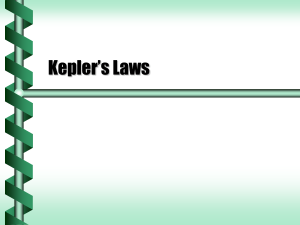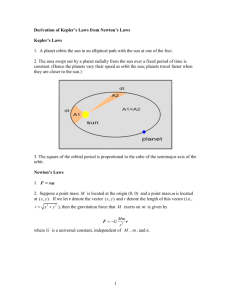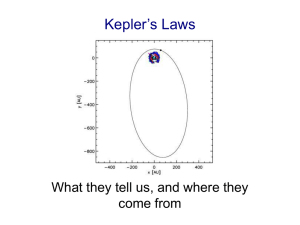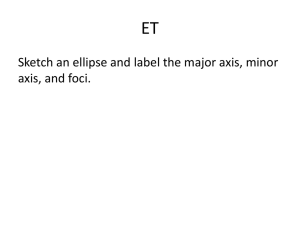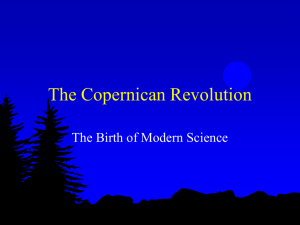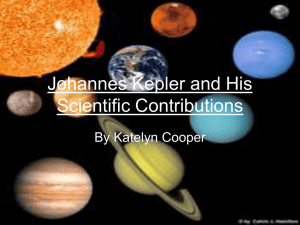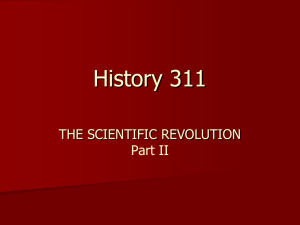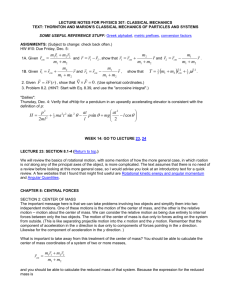卢德馨—示范课
advertisement
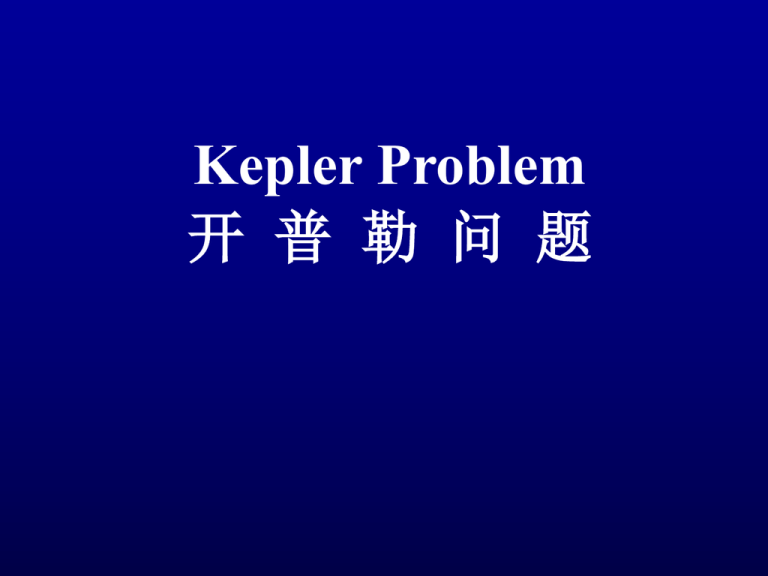
Kepler Problem 开 普 勒 问 题 行星运动的描述——运动学 地球人的观点 Sun path; analemma; star trails 历史的回顾: 地心说;日心说;开普勒 开普勒问题的文化方面 开普勒问题的物理 地球人的观点 Sun path; analemma; star trails Sun path by Justin Quinnell 2010 Analemma 地球仪8字曲线 by Tamas Ladanyi, TWAN Star trails by Harold Davis 星迹 历史的回顾: 地心说;日心说;开普勒 The frontispiece to Galileo’s Dialogue Concerning the Two World Systems (1632). According to the labels, Copernicus is to the right, with Aristotle and Ptolemy at the left; Copernicus was drawn with Galileo’s face, however Claudius Ptolemy (127—152 working in Alexandria, Egypt ) Nicolaus Copernicus (1473—1543) epicycle 本轮 equant eccentric earth deferent 均轮 Ptolemy system(70 circles) 均轮 偏心 本轮 Ptolemy system (70 circles) Copernicus system (46 circles) Galileo Galilei (1564—1642) Tycho Brahe (1546—1601) Johannes Kepler (1571—1630) Issac Newton (1642 — 1727) Kepler’s nested set: Saturn—Jupiter—Mars—Earth—Venus—Mercury cube dodecahedron octahedron tetrahedron icosahedron “Pythagorean” or “Platonic” solids •Mysterium Cosmographorum (Cosmic Mystery) (1596) •Harmony of the World (1619). Kepler's laws (1) The orbit of each planet about the Sun is an ellipse with the Sun at one focus. (the law of orbit); (2) The line joining any planet and the Sun sweeps out equal areas in equal times. (the law of areas); (3) The square of the period of revolution of a planet about the Sun is proportional to the cube of the planet's mean distance of the Sun. (the law of period or Harmonic law) 开普勒问题的文化方面 The task of deducing Kepler’s laws from Newton’s laws is called the Kepler Problem. Its solution is one of the crowning achievements on Western thought. It is part of our cultural heritage just as Beethoven’s symphonies or Shakespeare’s plays or the ceiling of the Sistine Chapel are part of our heritage. — The Mechanical Universe p498, CIT 4.4 Kepler problem and *scattering m1,r1 r r1 r2 m2 ,r2 m1m2 f ~G 3 r m 1 r1 f r r m 2 r2 f r r O Mathematician vs Physicist r r1 r2 m1 r1 m2 r2 0 1 1 r1 r2 f r r m m 2 1 Mathematician standard procedure of differential equation Physicist m, r; M, rC separate tendency & relative motion central force, conservation of L r, p co-planar, L m r 2 k L areal “velocity” constant 2m can never change sign. r1 r1 t r 2 r 2 t 1st integrals, conservation of E effective potential classification of orbits (not r1, r2 ) Thanks dxlu@nju.edu.cn 1 Define m1 r1 m2 r2 0 1 1 r f r r m m 2 1 m1 m2 mC m1 r1 m2 r 2 mC rC 1 1 1 m1 m2 m rC 0 m r f (r) r reduced mass Mass? Position vector? force? Which particle’s eq? 2 M r f r r 0 Lr pC Conservation of L • r and p are co-planar •L 2 r m r er r e m r k • areal “velocity” 2 M r f r r 0 Lr pC Conservation of L • r and p are co-planar •L 2 r m r er r e m r k 1 rd r 2 2 M r f r r 0 Lr pC Conservation of L • r and p are co-planar •L 2 r m r er r e m r k • areal “velocity” dA 1 r d r L constant dt 2 dt 2m • can never change sign. 3 1st integrals m r r 2 f r r 2 m r 2r 0 m r L dr dr 1 2 r dr dt dr r d r dt dt 2 2 2 2 L L L 2 r dr r 2 dr 2 3 dr d 2 2 m r mr 2m r m1m2 f (r ) r dr F dr dU d G r d v2 1 k 2 22 m r r E 2 r k r 4 Effective potential 1 2 2 mr 2 2 1 1 L 2 2 E m r U r m r U eff r 2 2 2m r 2 2 U eff k r 2m r 2 r L k ? r0 2 r ? r 2m r 2 L hyperbola Total energy Kinetic energy? parabola ellipse circle 11 5 r (t ) r r ( ) 2 1 L 2 E m r U r 2 2 2m r dr d L dr r 2 d dt m r d 12 2 L E U r 2 2m r m 2 d L 12 2 2 L 2 U r m r E 2 2m r m L 2 2 mr m 12 2 L k E 2 r 2m r dr L 2 1 mr 2 m 12 L2 2mk 2mE 2 r r dr r dr L m k L 2mk m k 2 2mE 2 2 r L L r 2 2 2 2 1 d 12 2 r 2 2 m k L mk 2mE 2 L r L L x ~ d arccos 2 2 a a x dx 2 12 1 d r arccos L mk r L 1 0 m 2k 2 2 2 2 mE L p p 1 1 r cos 0 r 2 2 e L L 1 2 mE 2 2 p m k mk p r 1 e cos( 0 ) k E 1 e 2p 2 p r 1 e cos( 0 ) 2 For ellipse orbit p p rmin r rmax 1 e 1 e rmin rmax p a 2 2 1 e b ap L p mk k E 1 e 2p eccentricity e=0 0<e<1 energy k E 2p k E 2a orbit circle ellipse e=1 E=0 parabola e>1 E>0 hyperbola 2 L2 p mk dA L A dt t dt 2m 2m 3 2 2m a b T a p L L mm 1 2m 3 2 L 32 a 2 a L mGmm (m m) Gmm 2 T 2 a 32 1 1 32 2 a ( Kepler ) G m m Gm *Hyperbola orbit 1 2 E m v0 2 L m v0b Scattering angle 2 2 p r 1 e cos cos 1 e k tan cot 2 Eb 2 cos cot sin Eq.(4.4.17) 1 1 e 1 2 e 1 2 2E 2E e 1 2 k L 2mE 2 2 m k 1 m 2 2 2 v0 b m Assignment: 4.7, 4.12, *4.14
